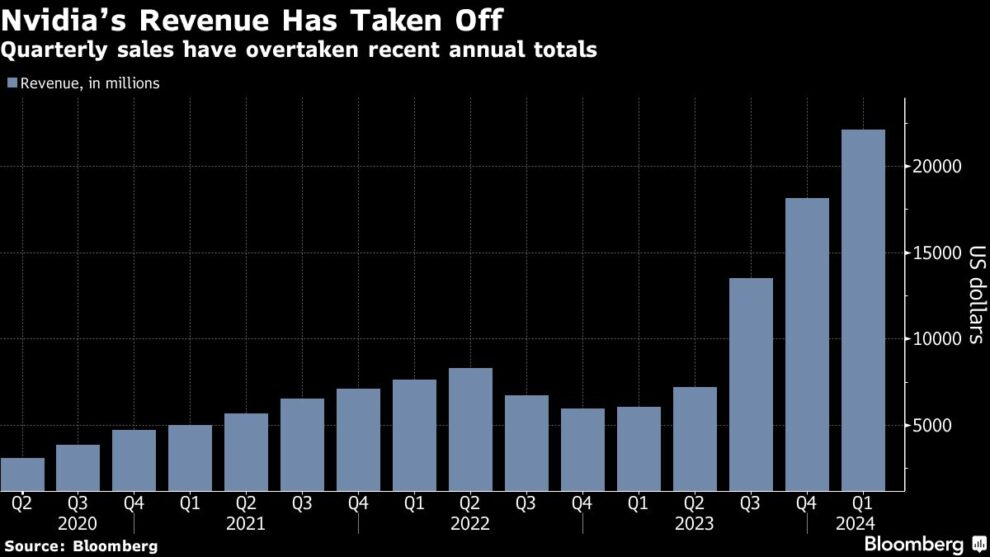
(Bloomberg) — Nvidia Corp., the chipmaker at the center of an artificial intelligence boom, gained in late trading after a bullish sales forecast showed that AI computing spending remains strong.
Most Read from Bloomberg
Second-quarter revenue will be about $28 billion, the company said Wednesday, topping the $26.8 billion predicted by analysts. Results in the fiscal first quarter, which ended April 28, also beat projections — lifted by growth in Nvidia’s data-center division.
The big question heading into the earnings report was whether Nvidia’s latest numbers could justify the dizzying run-up in its stock. The shares had gained 92% this year through Wednesday’s close, fueled by investor hopes that the company would continue to shatter expectations.
The report didn’t disappoint, and Chief Executive Officer Jensen Huang stoked the excitement by talking about the dawning of a new era. “This is the beginning of a new industrial revolution,” he said in an interview, echoing one of his favorite themes. “This is really exciting.”
The upbeat outlook reinforces Nvidia’s status as the biggest beneficiary of AI spending. The company’s so-called AI accelerators — chips that help data centers develop chatbots and other cutting-edge tools — have become a hot commodity in the past two years, sending its sales soaring. Nvidia’s market valuation has skyrocketed as well, topping $2.3 trillion.
In the fiscal first quarter, Nvidia’s revenue more than tripled to $26 billion. Excluding certain items, profit was $6.12 a share. Analysts had predicted sales of about $24.7 billion and earnings of $5.65 a share.
The shares rose as much as 7.8% in extended trading on Wednesday, taking them above $1,000 for the first time. The Santa Clara, California-based company also announced a 10-for-1 stock split and boosted its quarterly dividend by 150% to 10 cents a share.
The rally helped lift the shares of other companies associated with AI. Super Micro Computer Inc., Advanced Micro Devices Inc. and Dell Technologies Inc. all gained in the wake of the results.
Huang, in his signature black leather jacket, has become a celebrity in the AI era. His company, which he co-founded in 1993, started as a provider of graphics cards for computer gamers. But he recognized that Nvidia’s chips were well-suited to developing AI software and that helped open a new market — and gave him a jump on competitors.
The release of OpenAI’s ChatGPT chatbot in 2022 then sparked a race between major technology companies to build their own AI infrastructure. The scramble made Nvidia’s H100 accelerators a must-have product. They sell for tens of thousands of dollars per chip and are often in scarce supply.
For now, much of this new revenue comes from a small handful of customers. A group of four companies — Amazon.com Inc., Meta Platforms Inc., Microsoft Corp. and Alphabet Inc.’s Google — are Nvidia’s largest buyers and have accounted for about 40% of sales. Huang, 61, is trying to spread his bets by producing complete computers, software and services — aimed at helping more corporations and government agencies deploy their own AI systems.
Nvidia’s data-center division — now by far its largest source of sales — generated $22.6 billion of revenue last quarter. Gaming chips provided $2.6 billion. Analysts had given targets of $21 billion for the data-center unit and $2.6 billion for gaming.
If the after-hours stock gain holds up in regular trading on Thursday, Nvidia will add roughly $140 billion to its valuation. That’s greater than the entire market capitalization of Intel Corp., a chipmaker that once dwarfed Nvidia by every measure. And Nvidia’s $28 billion in projected quarterly sales would be more than twice what Intel is expected to report.
Nvidia emphasized Wednesday that it wants to sell its technology to a wider market — expanding beyond the giant cloud-computing providers known as hyperscalers. Huang said that AI is moving to consumer internet companies, carmakers, biotechnology and health-care customers. Countries also are developing their own systems — a trend referred to as sovereign AI.
These opportunities are creating multiple multibillion-dollar markets beyond cloud service providers, he said.
The large-scale deployment of Nvidia chips by Elon Musk’s Tesla Inc. is one sign of that expansion. The automaker is using Nvidia gear to develop software that will operate self-driving vehicles.
Still, hyperscalers remained a critical growth driver for Nvidia last quarter. They generated approximately 45% of the company’s data-center revenue. That suggests Nvidia is in the early stages of diversifying the business.
The company’s new chip platform, called Blackwell, is now in full production, Huang said. And it lays the groundwork for generative AI that can handle trillions of parameters. “We are poised for our next wave of growth,” he said.
The company will get “a lot” of its 2024 revenue from the new Blackwell chips, Huang said. But customers aren’t easing up on orders for its existing products — a concern among some analysts. Those buyers need the current generation to help them build out their infrastructure as quickly as possible, he said.
Demand for Nvidia’s products has outpaced supply, and Huang expects that to remain the case into next year. The company is also contending with other challenges: The increasing complexity of its technology, which now includes complete computer systems, means that its supply chain has become much more complicated, he said. That makes it more difficult to increase output.
“Nobody has ever manufactured supercomputers at volume,” he said in the interview. “We’re doing the best we can.”
Most Read from Bloomberg Businessweek
©2024 Bloomberg L.P.






